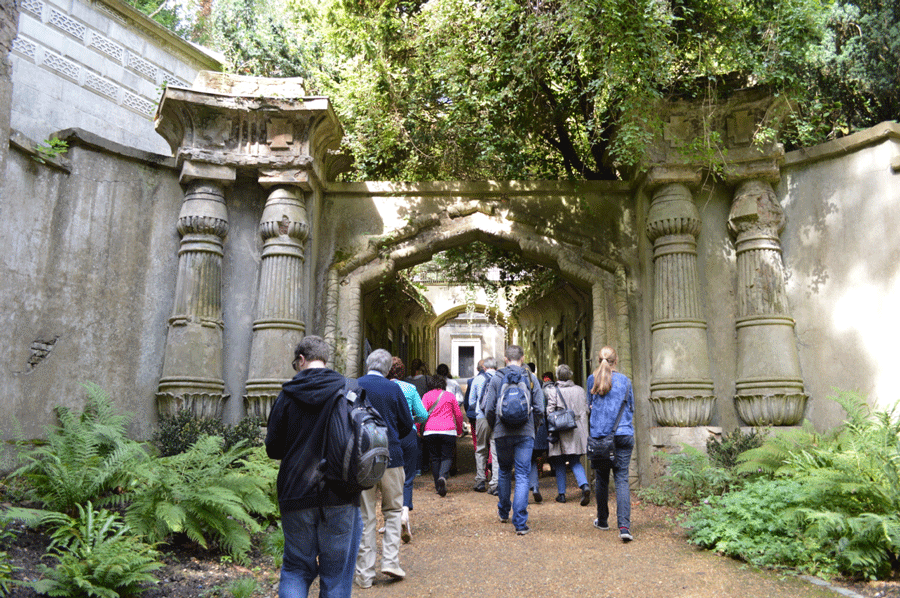
On March 13, 1970, London’s Highgate Cemetery was infamously mobbed by people looking for a vampire. Sean Manchester, then president of the British Occult Society,¹ lead “a group of one hundred persons” (Manchester 1985, 50)² to the Terrace Catacombs in search of the cemetery’s undead resident as part of an on-going investigation. Or so he claims.
Manchester chronicled his investigation in The Highgate Vampire: The Infernal World of the Undead Unearthed at London’s Famous Highgate Cemetery and Environs (1985; rev. ed. 1991). But if the book’s an accurate representation, it reveals he’s either grossly incompetent, fantasy-prone or a fraud.
How bad is it? He connected the vampire to five locations in the cemetery, yet somehow managed to misrepresent all of them. Geographic ineptitude, breaking the laws of physics harder than the vampire; they’re impressive feats for someone dubbed “Britain’s number one vampire hunter.” For instance:
#5. “Lusia” Is Pointing at the Wrong Tomb

“Lusia,” is the pseudonym Manchester bestowed on a 22-year-old victim of the vampire³ who was also prone to sleepwalking toward a specific tomb in the cemetery. He featured several photographs of her in his book, with one showing her pointing at a gate toward the end of the passageway in the cemetery. The photo is captioned: “the spot where her [Lusia’s] sleep-walk ended — before the large iron door” (Manchester 1985, 31), which he situates in the “Columbarium” (Manchester 1985, 24, 33, 46–7, 53, 54, 119).
I can’t show you Manchester’s original photo because he’s prohibited me from posting it on this site (Hogg 2014). But I’m at least able to tell you where the photo was taken: a passageway between the Edward La Bas vault and the Professor David Edward Hughes vault in the outer ring of the Circle of Lebanon (Fig. 1). The gate at the end sits below the cemetery’s imposing Beer Mausoleum. It is the same tomb Manchester says he visited on the night of March 13, 1970 (Manchester 1985, 50–1):
A group of one hundred persons led by myself, constituting the official vampire-hunt, made its way to the Columbarium in the inky darkness of Highgate Cemetery. The large iron door could not be opened. Try as we might, it would not budge an inch. I knew of another approach: a hole, just large enough for one person to squeeze through, in the roof of the elusive catacombs.
Manchester revealed the unnamed tomb’s identity in the revised edition: the “terrace catacombs” [sic] (Manchester 1991, 77). The Terrace Catacombs, one of the cemetery’s most notable tombs, “that extend[s] over 80 yards (73 m) and have 825 recesses, or ‘loculi’, positioned in the walls, either side from floor to ceiling, each designed to hold one coffin” (Bulmer 2014, 38).⁴ There’s just one problem: the gate Lusia pointed at does not lead to the Terrace Catacombs. Patsy Langley, Secretary of the British Psychic and Occult Society, elaborates (2007, 29):
it is clear to anyone who is familiar with the geography of Highgate Cemetery that the young lady [Lusia] is pointing to the lower depths of the Julius Beer Tomb [sic]. The Beer Tomb is very close by to the Terrace Catacombs, but it is quite separate from them. For one thing, the coffin entrance to the Beer Tomb lies in the Circle of Lebanon, whereas the entrance to the Terrace Catacombs is via an iron door on the opposite side of the path to the Beer Tomb, and it is this entrance, to which the young lady points.
In other words, Lusia was pointing at a location beneath the Beer Mausoleum, not at an entrance to the Terrace Catacombs. Manchester wouldn’t have been climbing through a hole in a roof; he would have been tunnelling through a mausoleum floor. David Farrant, President of the British Psychic and Occult Society, has also clarified the location (Farrant 2015):
The entrance to the Beer Mausoleum at the base [of the Circle of Lebanon] leads nowhere except inside the Mausoleum itself. Whether this once contained coffins, I do not know, but it is more likely it was just used for storage. Whatever, there is certainly no acess [sic] to the T. [sic] Catacombs which tower some twenty feet above this [the Beer Mausoleum]. Manchester must have assumed there was some access, which was why he got ‘Lusia’ to pose there.
This was not a one-off mistake: the same Lusia photograph features in Manchester’s revised account, but has a shorter caption: “Lusia at the catacombs where her sleep-walk ended.” (Manchester 1991, 72). Though that “mistake” hadn’t been revised, another was…
#4. The Columbarium Is Not the Circle of Lebanon
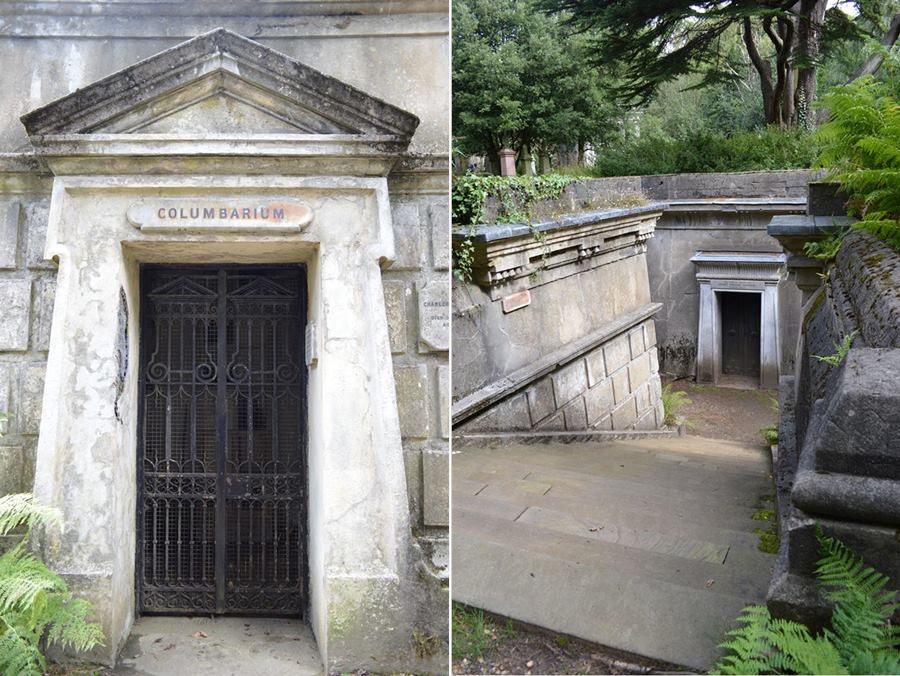
Manchester mentions the “Columbarium” several times in the first edition, but condenses these references to one in the revised edition (Manchester 1991, 52–3):
The tombs were built around this tree [in the Circle of Lebanon] and they have become known as the Lebanon Circle [sic]. The outer circle was not added until almost half a century later by which time the inner circle was full. By then catacombs were less fashionable and one of the compartments was converted to house cremated remains in 1893. This place is called the Columbarium.
This miniature history lesson about the Columbarium was clearly intended to compensate for his geographically-challenged references to the Columbarium in the first edition: he was actually referring to the Circle of Lebanon. The Columbarium, a vault in the Circle of Lebanon, specifically serves as a “place for urns” (“Highgate Cemetery” 2008); a tight fit for even the slimmest vampire.
A visitor to the cemetery even noted: “The Columbarium in Highgate was not what I expected. I took this picture through the grate that covered the door; in it you’ll see how tiny the spaces for the ashes were.” (Loiacano 2013) (Fig. 3)
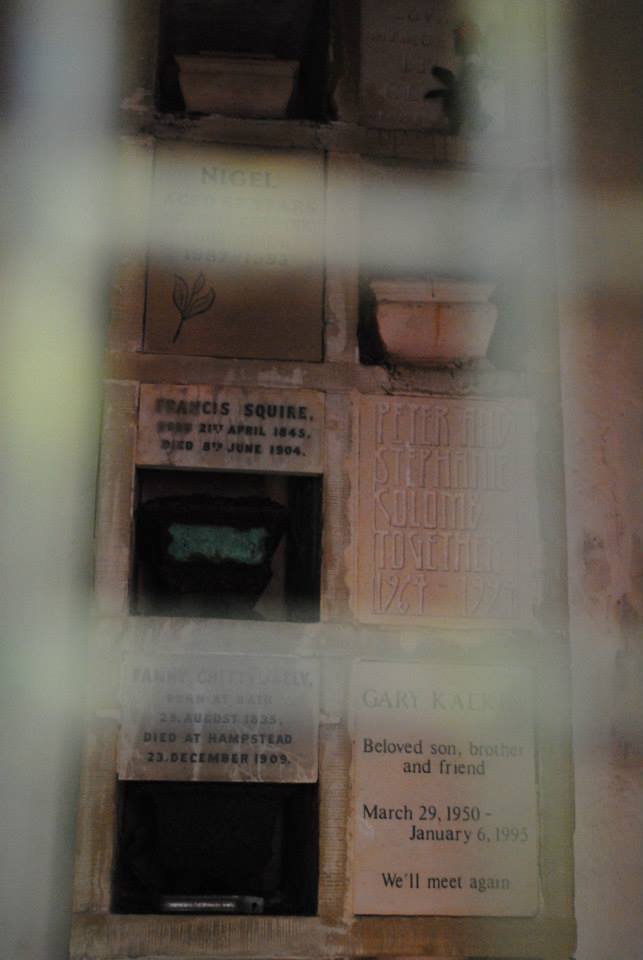
Despite being a local and the lead investigator of the “official vampire-hunt” (Manchester 1985, 47, 48, 49, 50, 53), Manchester took 21 years–from pronouncing his vampire theory to the press (“Does a Wampyr Walk in Highgate?” 1970) to the publication of the revised edition of his book in 1991–to realize his “mistake.”
How could Manchester have made such a glaring error? There is one possibility: a small wooden signpost on a stairwell leading into the Circle of Lebanon reads “To the Columbarium” (Fig. 2). Manchester probably thought the sign referred to the circle itself, instead of being a direction to a specific tomb.
#3. There’s No Hole to Climb Through in the Terrace Catacombs’ Roof; There’s a Rational Explanation for the Three Empty Coffins
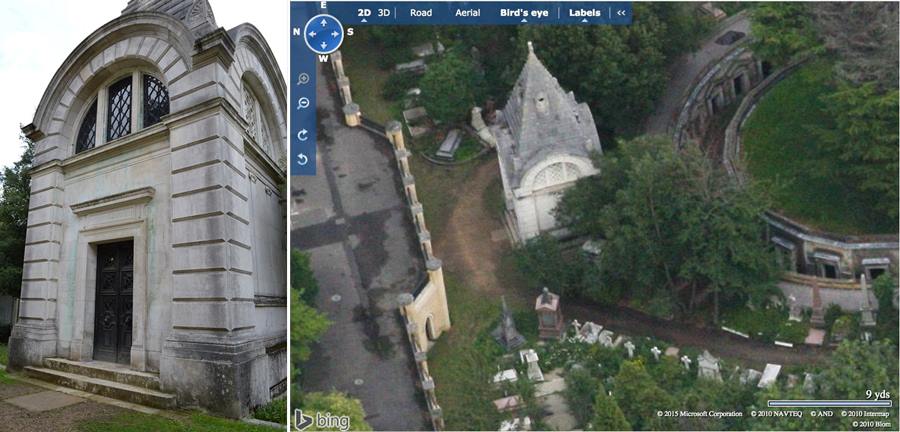
Remember when Manchester said he climbed through a hole in the Terrace Catacomb’s roof? “I knew of another approach: a hole, just large enough for one person to squeeze through, in the roof of the elusive catacombs.” (Manchester 1985, 50–1) Yeah, there’s no way he could’ve done that.
As previously mentioned, the Terrace Catacombs are not directly above the lower gates to the Beer Mausoleum as Manchester’s “pointing” photograph suggests; the catacombs are actually located on an upper level above the Circle of Lebanon, about 20 feet in front of the Beer Mausoleum’s front entrance (Fig. 4).
The distance between the Beer Mausoleum and the Terrace Catacombs makes Manchester’s ceiling descent impossible: they’re separated by solid ground with a dirt track on top. So what’s with the ceiling access point Manchester referred to? (Manchester 1985, 50–1):
It was quite a drop and I had to be lowered by a rope some twenty feet. Two assistants followed and we searched the musty, damp interior for signs of the undead’s resting place, brushing aside cobwebs and items of decay as we went.
The “hole” became an “aperture” in the revised edition and “the elusive catacombs” become “the terrace catacombs” [sic] (Manchester 1991, 77), but the details otherwise remain the same. But according to Patsy Langley: “No hole exists in the roof of the Terrace Catacombs; neither does it exist in the roof of the Julius Beer Tomb, which has graves and a small garden atop it.” (2007, 30)
But that depends on how you interpret a “hole” in the catacomb’s roof. During my Aug. 30, 2014 visit to the cemetery (Chapman 2014), my tour group went into the Terrace Catacombs. The catacombs were lit by oculi and the tour guide’s flashlight. The oculi in the catacombs are circular openings in the ceiling which let sunlight in (Fig. 5; Fig. 6).
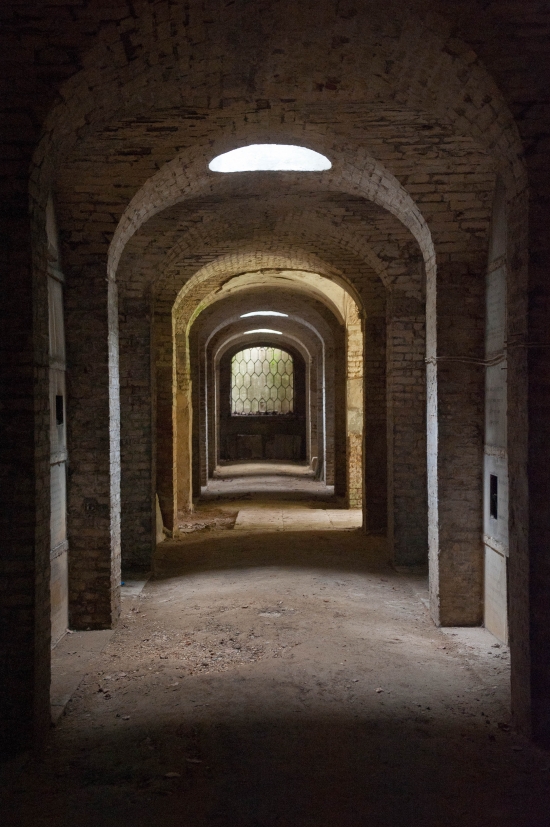
Had Manchester accessed the catacombs through one of them? The oculi looked about 2 feet across to me from my position on the ground, but I sometimes struggle with depth perception due to my short height. So, I asked my partner—who’d accompanied me on the visit—how big he thought they were. Was it possible for someone to squeeze through them?
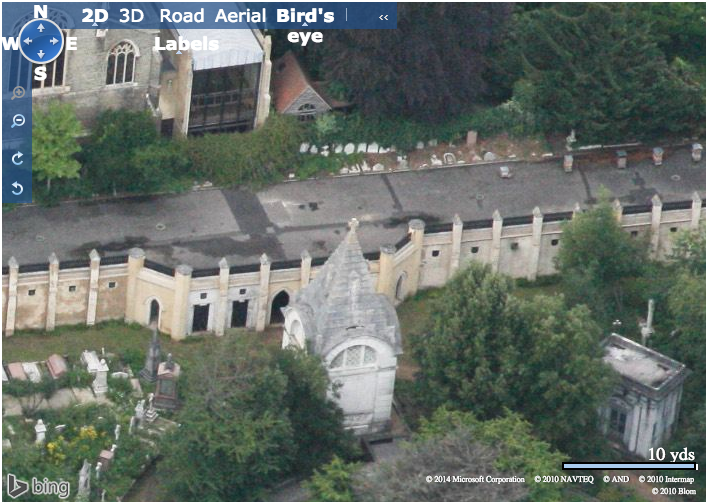
He said no, there was no way an adult could have; he added it would’ve been a struggle even for his skinny 14-year-old son. Meanwhile Manchester (b. July 15, 1944) was 25-years-old at the time he supposedly climbed in through the catacomb roof on March 13, 1970. His physical appearance on the front page of the March 6, 1970 edition of the Hampstead & Highgate Express (“Why Do the Foxes Die?” 1970) and his interview on BBC’s 24 Hours program (Oct. 15, 1970) shows he certainly didn’t have the physique of a skinny 14-year-old boy. David Farrant also confirmed the impossibility of entering the catacombs through the oculi (Farrant 2015):
The holes in the roof of the Terraced [sic] Catacombs were (are) only for light and ventilation and are not larger than approx [sic] 10 inches in diameter and were sealed by thick opaque glass. It would be impossible for a full grown man to get through these – even a small child.
Farrant knows that from personal experience. As Patsy Langley reveals in The Highgate Vampire Casebook (A Final Reported on the Alleged Existence of a ‘Vampire’ Said to Have Haunted London’s Highgate Cemetery) (2007, 31):
had the author [Manchester] got the correct place all along, there would not have been any need to enter the Terrace Catacombs by any roof hole, for there exists on either side, two ventilation outlets, which are large enough for a man to squeeze into. David Farrant, BPOS President, has confessed to climbing through these apertures himself and told this author that this was the popular (if illegal) way of gaining access and egress.
Farrant has further elaborated on his access to the catacombs (Farrant 2015):
When I entered the Catacombs during the day with a reporter tt [sic] was through a sunken entrance at the end. This had been sealed by thick iron bars, but vandals had sawn through two of these and it was easy to climb in.
If Manchester wasn’t able to gain access to the catacombs the way he described, what do we make of the coffins he and two assistants supposedly found in there on their first visit (Manchester 1985, 51):
we searched the musty, damp interior for signs of the undead’s resting place, brushing aside cobwebs and items of decay as we went. In all we found three evacuated coffins which we proceeded to line with garlic and a cross. A circle of salt was poured around and holy water sprinkled inside each. Having done this we ascended the rope and rejoined those above.
And on the second after an incident involving two teenage girls stumbling across evidence of tomb desecration in a different part of the cemetery (Manchester 1985, 53):
I felt that it was time to re-examine the vaults of the Columbarium [sic] and their mouldy contents; not least of all the cavernous crypt which contained the three empty coffins. Lowering myself through the small opening in the roof, I once again descended the rope and looked for the coffins. Two were resting on the floor, exactly as I had left them with, perhaps, a few additional cobwebs. But one was missing.
Just in case it’s not clear he’s describing breaking into the Terrace Catacombs, the revised edition clarifies the location of the coffins (Manchester 1991, 82):
Lowering myself through the narrow opening, I once again descended the rope and searched for the caskets which I had lined with vampire antidotes. My flashlight caught them in its beam at the far end of the terrace catacombs [sic].
As previously mentioned, the Terrace Catacombs “extend over 80 yards (73 m) and have 825 recesses” (Bulmer 2014, 38). The recesses are like book shelves; only the books are coffins. The British Listed Building website notes the “Apertures [are] sealed with inscribed slabs or small glass inspection windows” (“The Catacombs and Terrace in Highgate (Western) Cemetery, Camden” n.d.).
But the oculi are not electric lights. I personally saw how dark they are during the day, but at night time in pitch black darkness? Highly unlikely, unless they knew exactly where to go. After all, how was Manchester able to find three empty coffins in a catacomb with sealed apertures? Had someone removed them from their recesses? Did Manchester and his assistants pull them free? He doesn’t say.
Either way, there’s a much more likely explanation for the empty coffins than “vampires.” Here’s Patsy Langley’s suggestion (2007, 32):
Mr Law, Superintendent of the cemetery spoke on the BBC ’24 Hours’ programme in October 1970, stated that he found ’empty coffins everywhere’ and that he forever had to replace them on their shelves. Farrant concurs: ‘The Cemetery Superintendent told the Court that he was always clearing up the coffins and contents following the actions of vandals.’ So why assume that a vampire lay in these coffins, and not ordinary bodies, which had been disturbed by vandals searching for lead?
Good questions, but Manchester already had an explanation: the vampire had simply moved into another tomb. Except…
#2. The Wace Vault Is Not Next to the Terrace Catacombs, and It Wasn’t Bricked Up to Keep a Vampire Inside
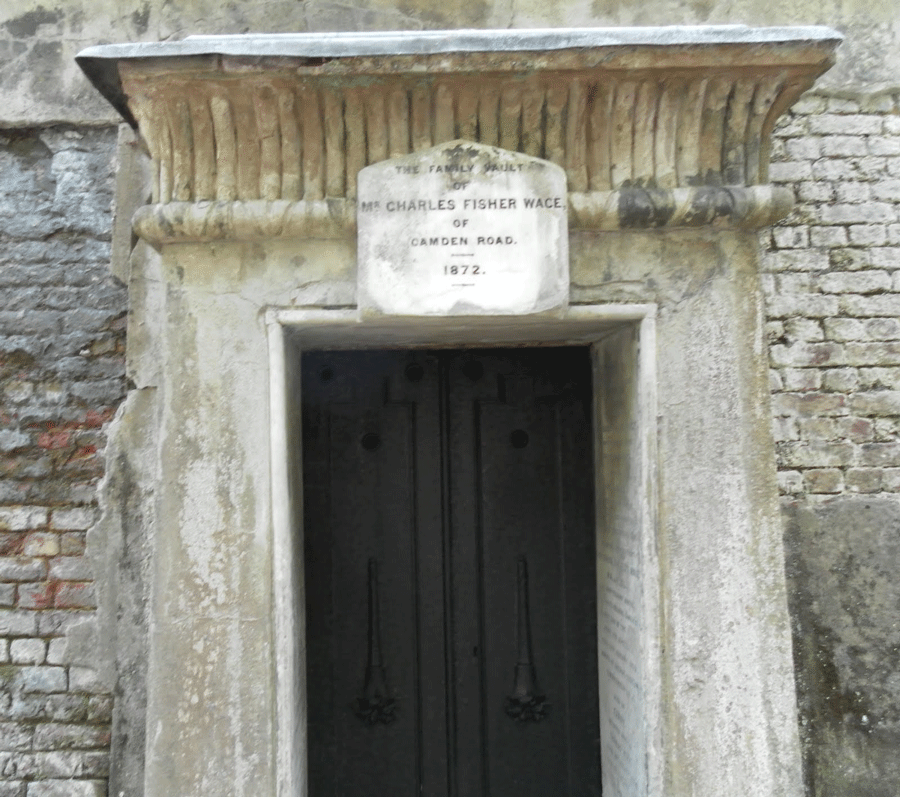
On July 31, 1970, two teenage girls walking through the cemetery came across the headless corpse of a woman who’d been buried in 1926, “lying on the grass outside a vault.” Manchester told a reporter that the tomb desecration had been committed by Satanists, who were intending to resurrect a vampire (“That Vampire Back Again?” 1970). That context would’ve been welcome in his book where he instead says (Manchester 1985, 53):
The body, discovered by three [sic] fifteen-year-old schoolgirls, was lying on the grass was lying on the grass outside a vault just a few yards from the spot where Lusia had led us in her sleep-walk. Here lay the key to the mystery — staring us in the face — yet we could not see it. I felt that it was time to re-examine the vaults in the Columbarium and their mouldy contents; not least of all the cavernous crypt which contained the three empty coffins.
Manchester found one of the coffins missing. He then sought out Lusia, his psychic vampire detector, to try and find the vampire after hypnotizing her—and she didn’t disappoint (Manchester 1985, 54):
She ran to the iron door [of the Terrace Catacomb] and grabbing its rails screamed “Where are you?” yet again. It echoed through the catacombs. Then, turning, she slowly walked to a vault entrance nearby and began sobbing. It was the vault outside which the headless corpse had been discovered. I consoled Lusia and carefully brought her out of the trance.
The event plays out a little differently in the revised edition (Manchester 1991, 84):
She slowly walked from the barred catacomb entrance until she faced the vault in the Lebanon Circle where the headless corpse had been found by schoolgirls. Here she collapsed.
Lusia’s tears (or collapse) is enough evidence for Manchester and his assistants to force their way into the tomb: “We all put our shoulders to the old doors and slowly inch by inch, they creaked open until we were able to gain entry.” (Manchester 1985, 54) Manchester found the vampire inside the vault, but held back from staking it after complaints from his companions suggesting the act would be both illegal and sacrilegious. Manchester settled for an exorcism he was not qualified to perform (not being a priest at the time) and “Upon my [his] recommendation the entrance to the vault was permanently bricked-up. Garlic was included in the cement used in sealing the only exit.” (Manchester 1985, 58)
If I were a vampire and someone found my house, I would’ve moved to another cemetery, not a few tombs away! Either way, the vault’s name is notable by its absence; probably because he could’ve faced charges of tomb desecration for admitting to such a blatantly illegal act. But Manchester didn’t need to name it because his photographic evidence reveals its location: he’s talking about the Family Vault of Mr. Charles Fisher Wace.
We know it’s the Wace vault (Fig. 7), located in the Circle of Lebanon, because Manchester enclosed two photographs of it—on the same page—in his 1985 book and identified it as the same vault where the exorcism took place. The first shows Manchester “Entering the tomb of the Highgate Vampire shortly before the formal ritual to cease its nightly wanderings.” The second is captioned: “The exorcised vault, bricked up and sealed with garlic — but was the vampire still within?” (Manchester 1985, 61). The photograph showing Manchester entering the Wace vault was omitted from the revised edition, but the second photograph was included and re-captioned: “The exorcised vault, bricked up and sealed” (Manchester 1991, 91).
I’m not allowed to reproduce those images, because Manchester’s prohibited me from hosting those too (Hogg 2014). So let’s focus on Manchester’s geographic description of the vault, which he placed it “just a few yards from the spot where Lusia had lead us on her sleep-walk” (Manchester 1985, 53). As you’ll recall, Lusia had lead them to the Terrace Catacombs and while under hypnotic trance, she lead them to “a vault entrance nearby and began sobbing. It was the vault outside which the headless corpse had been discovered” (54). The problem is, these locations are not merely “a few yards away” from each other (Fig. 8).
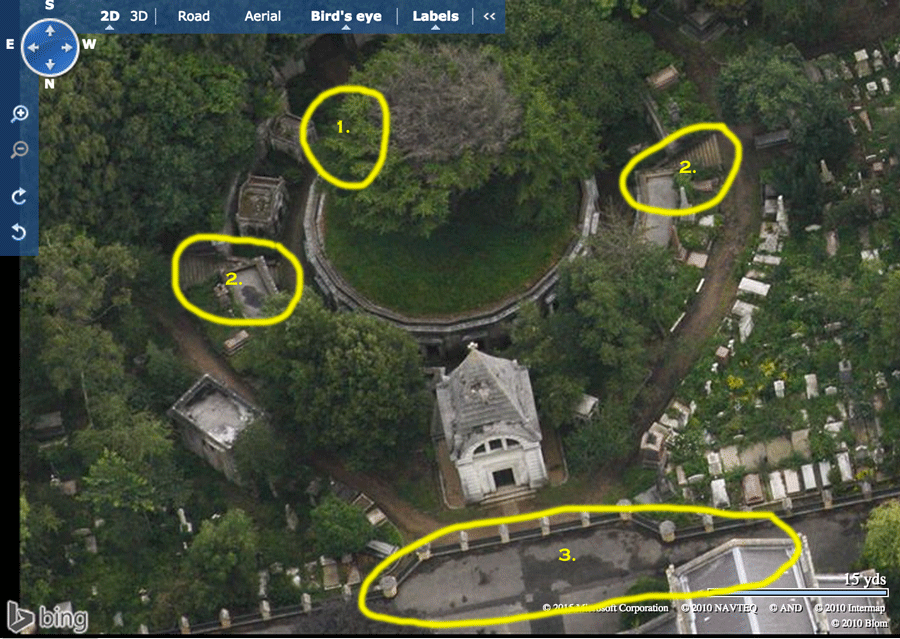
As you can see from the picture, above, you would have to walk away from the Terrace Catacombs, down the dirt track, down a stairwell (take your pick: there’s two) and then sob or collapse in front of the Wace vault. That’s a lotta “yards”!
What about Manchester’s “recommendation” that the Wace vault be bricked up Considering that the cemetery had already been vandalised by “vampire hunters” and other pests, it is highly unlikely any such recommendation would have taken place at all (Langley 2007, 35):
Why did he not ask for the key if he suspected something out of the ordinary, or acquire permission from the Home Office to enter the tomb? He has stated elsewhere that he asked the workmen to help him, and maybe he thinks this covered legal aspects of this venture, but both they and he, were breaking the law. No person is allowed to enter a vault or tomb without good reason, and that reason must be relayed to the Home Secretary, who will either grant or decline permission. Suspecting a vampire is not a good enough reason , and permission would be declined.
Langley offers another suggestion as to why the tomb may have been bricked up (35–6):
The author claims that the door was bricked up on his recommendation (sic) but when one compares the look of other tombs on the BBC 24 Hours programme [Oct. 16, 1970], they appear also to have been bricked up on the recommendation of a vampire hunter, it seems that the cemetery authorities had bricked up the entrances to all the tombs in the Lebanon Circle to prevent illegal entry by vandals, thrill seekers, and of course, vampire hunters.
Interestingly, Manchester also alludes to bricked-up vaults in the Circle of Lebanon, where the Wace vault is located, long before mentioning his unqualified exorcism: “Some of the tombs had their entrances bricked up since the tranquillity was disturbed strange goings-on in past years” (Manchester 1985, 24, 33).
I’ll now hammer the final nail (or stake?) in the coffin of Manchester’s vampire meanderings by discussing another Lusia photograph in his book, which reveals that the “exorcism” at the Wace vault was not all it appeared to be…
#1. The Family Vault of Sir James Tyler: Wrong Tomb; Exorcism Description Doesn’t Match
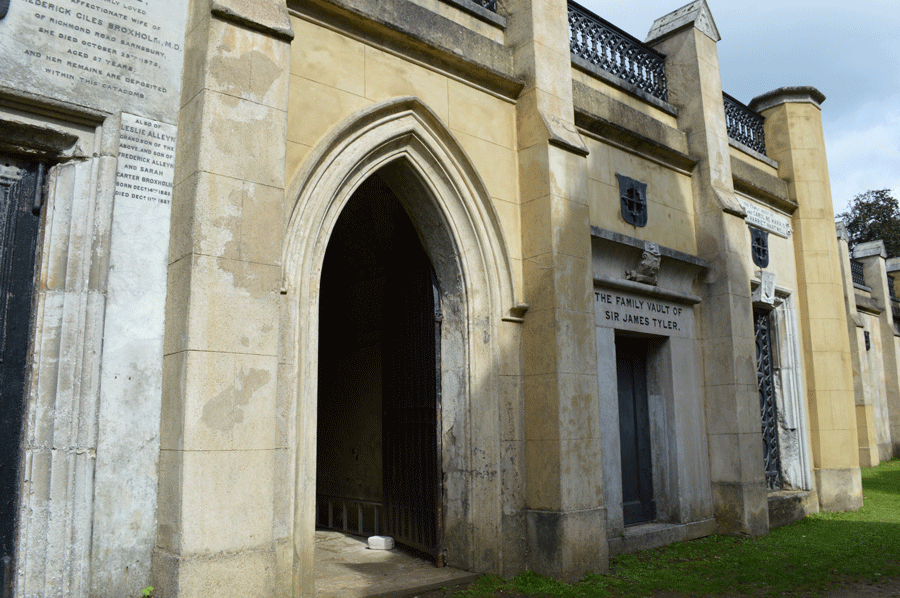
The Wace vault’s doorway played host to Manchester’s impromptu exorcism after his attempt at staking the Highgate Vampire was frustrated his his companions (Manchester 1985, 57):
We retreated to the doorway and outside I prepared a circle of salt inside of which we all stood. Handing a crucifix to each of the participants I requested that they all pray in silence for a few moments, asking for strength and support to banish this fountainhead of unspeakable evil for ever. I explained to Lusia that during the ensuing ceremony she must remain inside the circle and do exactly as instructed. I gave her a bible to hold open at the fifty-fourth Psalm.
The event was illustrated with a drawing by Chrissie Demant in the revised edition (Manchester 1991, 88) which features a salt circle surmounted by four tall candles. But in the first edition, the event is represented with a photograph captioned: “Lusia inside a protective circle cut into the ground outside the catacombs feared to be the resting-place of the vampire” (Manchester 1985, 59).
Lusia is the only person in the shot. She is crouched on the ground, pointing not at a “circle of salt,” but a pentagram or pentacle inscribed into a dirt path. Over her shoulder, we see the Family Vault of Sir James Tyler (Fig. 9) which is part of the Terrace Catacombs, but nowhere near the Wace vault (Fig. 8).
There are no other instances to a “protective circle” being used to aid Lusia in Manchester’s narrative, so we can reasonably conclude they represent the same event. Manchester even took the time to clarify his “circle” references in the prefatory notes to his investigation narrative (Manchester 1985, 18):
Although not pre-eminently religious, I have been left in no doubt by the course of events that evil is not just an abstract force and, most important of all, that such demonic molestation as I have encountered is no match for divine power once invoked. The set of symbols I work with are predominantly Christian, yet you will find in the text that I cast a circle, what some might call a Magic Circle. While I am not a witch in any sense of the word, I suppose as a secular person handling consecrated material as a protection against hostile psychic forces, I am practising “white” magic. The Circle once cast is a ritualised barrier, a consecrated sanctuary; like a church, mosque or synagogue — like Avebury, Stonehenge and Glastonbury.
Not “pre-eminently religious”? Magic Circles? Strange things for the founder of a Christian sect to say.
Acknowledgements
I would like to thank my colleague, Anthony Hogg, for his assistance with this article. His experience and knowledge on the Highgate Vampire case has proven to be an invaluable resource.
Notes
¹ Sean Manchester represented himself under this title when he voiced his vampire theory to the local press (“Does a Wampyr Walk in Highgate?” 1970), but his title is disputed by David Farrant, current president of the British Psychic and Occult Society, who claims he was the BOS’s president at the time (Farrant 2014).
² An unlikely figure as a contemporary report mentions: “NEARLY 100 people joined in a vampire hunt” with no mention of Manchester’s presence (“Satan Riddle of Open Tomb” 1970); Manchester also revised his “100” number to “a group of hand-picked researchers” (Manchester 1991, 77).
³ “Lusia” has since been identified as Jacqueline Cooper, Manchester’s lover at the time (Hogg 2012). Manchester did not disclosure their relationship in his narratives; probably because he was still married to Marie Manchester (née Ryan) at the time.
⁴ However, the British Listed Buildings website lists 840 recesses (“The Catacombs and Terrace in Highgate (Western) Cemetery, Camden” n.d.).
References
Bulmer, Jane. 2014. Highgate Cemetery. Saved by Its Friends. London: Highgate Cemetery and Jigsaw Design & Publishing.
“The Catacombs and Terrace in Highgate (Western) Cemetery, Camden.” n.d. British Listed Buildings. Accessed Dec. 5, 2014. http://www.britishlistedbuildings.co.uk/en-478284-the-catacombs-and-terrace-in-highgate-we.
Chapman, Erin. 2014. “Seeking Vampires in London.” Vamped. Nov. 16. Accessed Dec. 6, 2014. http://vamped.org/2014/11/16/seeking-vampires-in-london/.
“Does a Wampyr Walk in Highgate?” 1970. Hampstead & Highgate Express, Feb. 27, 1.
Farrant, David. 2014. “About David Farrant.” David Farrant. Accessed Dec. 6, 2014. http://www.davidfarrant.org/about/.
———. 2015. E-mail message to author, Jan. 24.
“Highgate Cemetery.” 2008. BBC. Last modified Oct. 27. Accessed Dec. 7, 2014. http://www.bbc.co.uk/london/content/articles/2005/05/10/highate_cemetery_feature.shtml.
Hogg, Anthony. 2012. “An Interesting Find.” Did a Wampyr Walk in Highgate? (blog), Jan. 21. Accessed Feb. 23, 2015. http://dawwih.blogspot.com.au/2012/01/interesting-find.html.
———. 2014. “‘Vampire Hunter’ Hammers Stake Through Article.” Vamped, Nov. 27. Accessed Feb. 25, 2015. http://vamped.org/2014/11/27/vampire-hunter-hammers-stake-through-article/.
Langley, Patsy. 2007. The Highgate Vampire Casebook (A Final Report on the Alleged Existence of a ‘Vampire’ Said to Have Haunted London’s Highgate Cemetery). London: British Psychic and Occult Society.
Loiacano, Courtney. 2013. “Highgate Cemetery and Falling Angels.” Woman Writing London (blog), July 30. Accessed Feb. 25, 2015. https://womenwritinglondon.wordpress.com/2013/07/30/highgate-cemetery-and-falling-angels/.
Manchester, Sean. 1985. The Highgate Vampire: The Infernal World of the Undead Unearthed at London’s Famous Highgate Cemetery and Environs. London: British Occult Society.
———. 1991. The Highgate Vampire: The Infernal World of the Undead Unearthed at London’s Highgate Cemetery and Environs. Rev. ed. London: Gothic Press.
“Satan Riddle of Open Tomb.” 1970. Evening News (London), March 14, 1.
“That Vampire Back Again?” 1970. Hampstead & Highgate Express, Aug. 7, 1.
“Why Do the Foxes Die?” 1970. Hampstead & Highgate Express, March 6, 1.
As Bill Hicks would say: “Case. Fucking. Closed.” Coincidentally, today marks the 45th anniversary of “Does a Wampyr Walk in Highgate?” (Feb. 27, 1970) the Ham & High article which first broadcast Sean Manchester’s vampire theory to the general public. Happy Birthday, Highgate Vampire!
The newspaper’s headline inspired the blog, Did a Wampyr Walk in Highgate?, which you should also totally check out.
Great stuff.
Don’t understand why our website went away. Mark Benecke did a great job with it but one day it wasn’t there. Like wampires at Highgate…
Here is your website Jeanne: http://wiki2.benecke.com/index.php?title=The_Vampire_Empire
Well done Erin! Obviously quite lot of work has gone into preparing this article. And kudos also go to Anthony for all the help and assistance he has provided you. Now normally I would’ve said it’s a shame that Sean Manchester has prevented you from using his (highly posed) Highgate Cemetery photos (all within the context of fair use of course) with his pathetic DMCA threats, but in all honestly it’s not a deal beaker. You’ve provided more than adequate references to the censored material, should anyone want to seek them out for themselves. All in all you’ve helped hammer yet another nail in this (decidedly anaemic) vampire’s coffin.
One wonders what the good ‘Bishop’ will do now in the aftermath of such devastating revelations? Other than offering the world a (further) revised third edition perhaps? Myself, I think he is truly up s**t creek without a paddle with this one!
I can tell you, Redmond: he’s gone after my recent interview in “Spectral Times,” the one mentioned in here: http://vamped.org/2015/03/01/behind-the-curtain-vampeds-administrators-interviewed/
It has been significantly revised. PM me on Facebook if you want a copy of the original. A blog post to follow. In the meantime, enjoy this: https://pennwic.wordpress.com/2015/02/25/fair-use-and-vampires/
Thanks Redmond! It took almost 3 months to get this thing done. It was a mess to work through that’s for sure.
Ok, let me see if I’ve got this right. You’re saying that after your interview was published on The Spectral Times, Manchester had it pulled? I’ve just had a read of the excised passages that you posted on The Faustian Circle and I can confirm that they were definitely all there when I read the e-edition that I had downloaded the other day. Do I now have in my possession a limited edition? lol
But seriously, it was pulled on the grounds of defamation and libel?!
Manchester contacted the editor, accused me of defamation, libel, etc. and the editor took out the “offending” passages to avoid “stepping on any toes.” The interview that presently appears there is an abridged version of what I originally wrote (the excised bits which can be seen, as you noted, on the Faustian Circle): http://faustiancircle.blogspot.com/2015/02/the-highgate-vampire-hunters-readers.html?showComment=1425268862393#c4128147662128661933
So, yep: you’ve got a limited, pre-censored edition of the Spectral Times. Treasure it!
Erin and Anthony, you might be interested to know that Sean Manchester has published a rebuttal (of sorts) to this excellent article.
Posting under the alias ‘Christian England’, he states categorically that:
“Just as he (Manchester) neither wanted nor intended the identity of certain people to be revealed, eg Dennis Crawford, “Arthur” and “Lusia” etc, there were some places, then very accessible to members of the public, which he did not want to be clambered over or invaded by dilettantes and amateur sleuths.
Hence he used a model (later an actress) to portray “Lusia” in books, filmed dramas and documentary reconstructions; purposely misdirecting in published photographs of her the places referenced in The Highgate Vampire so that vaults and tombs would not suffer as a consequence.
Bear in mind that this was a time way before the creation of Friends of Highgate Cemetery (FoHC) who took it upon themselves to care for the place; a time when the graveyard was open season to anyone with a mind to engage in their own enquiries, as well as those of more malign intent.
His book does include images of the suspected vampire tomb, both before and after it was bricked up, but this had already been revealed in a photograph by a local newspaper when a private exorcism took place in August 1970. Moreover, once it had been sealed and cemented with bricks it hardly presented an easy invitation for entry. By the time the bricks were removed in later years the hysteria and panics had subsided and the cemetery was being closely monitored and managed by FoHC.
Seán Manchester, of course, was and remains intimately familiar with Highgate Cemetery and unsurprisingly knows its topography better than most people. As someone who has sought to prevent the destruction of graveyards in the wake of the Disused Burial Ground Amendment Act of 1981, he would naturally purposely set out to protect Highgate Cemetery.
As well as being a good friend of the late Jean Pateman, someone who kept him updated after he left London and the person who ran FoHC until her death in 2012, Seán Manchester stood as an independent candidate in May 1982 on the single issue of preserving a woodland cemetery.”
What did I say again about damage limitation? lol
Link: https://www.facebook.com/groups/Sean.Manchester.Vampirologist/permalink/413234338855641/
As Manchester has clearly stated: “Nobody is authorised to speak in my stead”. Source: http://therightreverendseanmanchester.blogspot.com.au/2009/08/from-dna-to-demons.html
Therefore, “Christian England’s” word is unauthorised and totally without substance. Besides, the evidence speaks for itself.
There’s no refuting who Lusia is (who Manchester identifies, repeatedly, in his book as “Lusia” but is actually Jacqueline Cooper, his former lover), not to mention Manchester’s pitiful grasp on topography punching large holes in his vampire story.
If “Christian England’s” best defense is “Manchester was lying,” that says it all, really.
So the best excuse Manchester could come up with was, “purposely misdirecting in published photographs of her the places referenced in The Highgate Vampire so that vaults and tombs would not suffer as a consequence.” So basically *he* screwed up on purpose lol?
Here’s the thing: in both cases *he* was the publisher! The book was published under both his imprints: British Occult Society (1985) and Gothic Press (1991).
That’s no screw-up, that’s deliberate deception at best. What “Christian England” forgets, however, is that “Lusia” appears under her actual name in both Roy Stockdill’s News of the World article “Beat-the-Devil Priest Calls in Magicians” (Jan. 24, 1971)and Manchester’s own Witchcraft article “The World of the Vampire” (1973).
Photographs of Jacqueline/Lusia are also featured in Manchester’s book, not to mention corresponding events like Manchester’s blessing of the desecrated St. Clemens’ Church, Islington (Manchester 1985, 86–8), where Manchester even says (87):
“I included Lusia – still my only psychic link with the dark force – with the entourage of assistants on that grim afternoon when I returned, giving strict instructions for everyone to avoid touching the defiled objects. As they had been returned to St Clement’s Church, I was left no alternative but to deal with them there.”
But Stockdill’s article reveals “Lusia’s” true identity: “I watched as Mr. Manchester, aided by his attractive wife, blonde, mini-skirted Jacqueline [Cooper], conducted a five minute ceremony”.
That passage reveals another lie: Cooper wasn’t Manchester’s wife; Marie Ryan was. Hence, Lusia/Jacqueline was actually Manchester’s former lover.
Another myth busted.
Ah yes, I forgot about the publisher bit. Pretty hard to wiggle out of that one lol.
And for all of you that want to know some behind the scenes on this article check out my latest blog post! http://vamped.org/2015/04/04/cemetery-logistics-how-i-tracked-the-highgate-vampire/
This is devavu! I was having this argument 20 years ago when i ran Crimson magazine!! I got invited to the ‘bishops’ ordination but was unable to attend. I still have original photos of the event from people who did. This is a far better autopsy of +Sean’s lies than I ever published but i have all the original articles from when i was threatened with the usual non existant court proceedings. I can’t believe he’s still flogging this dead vampire… sorry… i mean horse!
Dear Sir/Madam.
I am a member of the Friends of Highgate Cemetary and we are often asked about the vampire infestation on guided walks. Our response is normally that it was a long time ago and there has been enough disturbance and sensationalism already. Whether there actually was a psychic manifestation of an age-old entity? who knows!!
The evidence suggests otherwise.